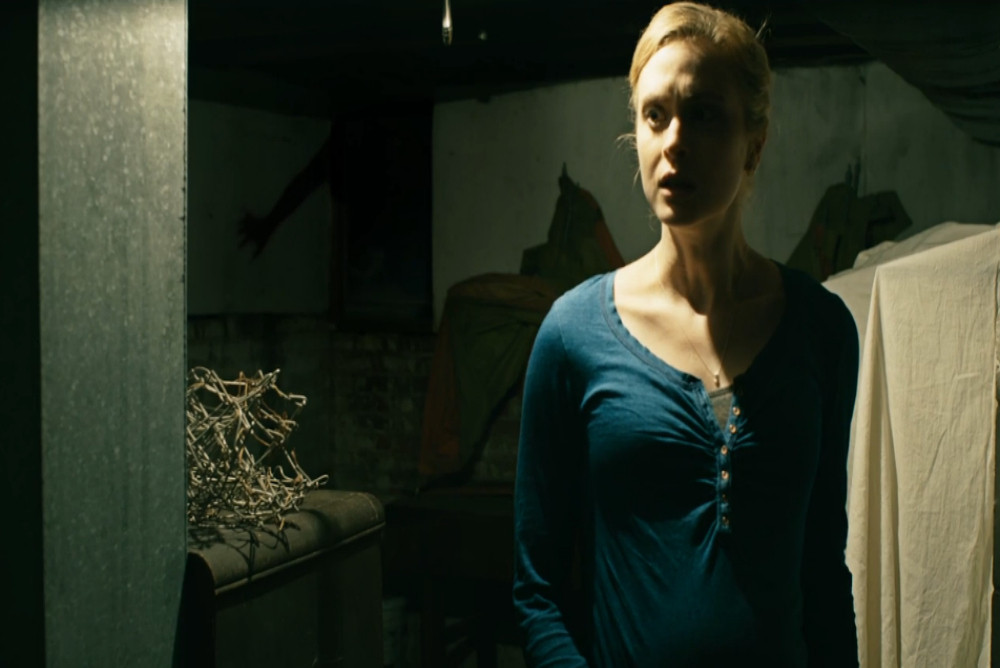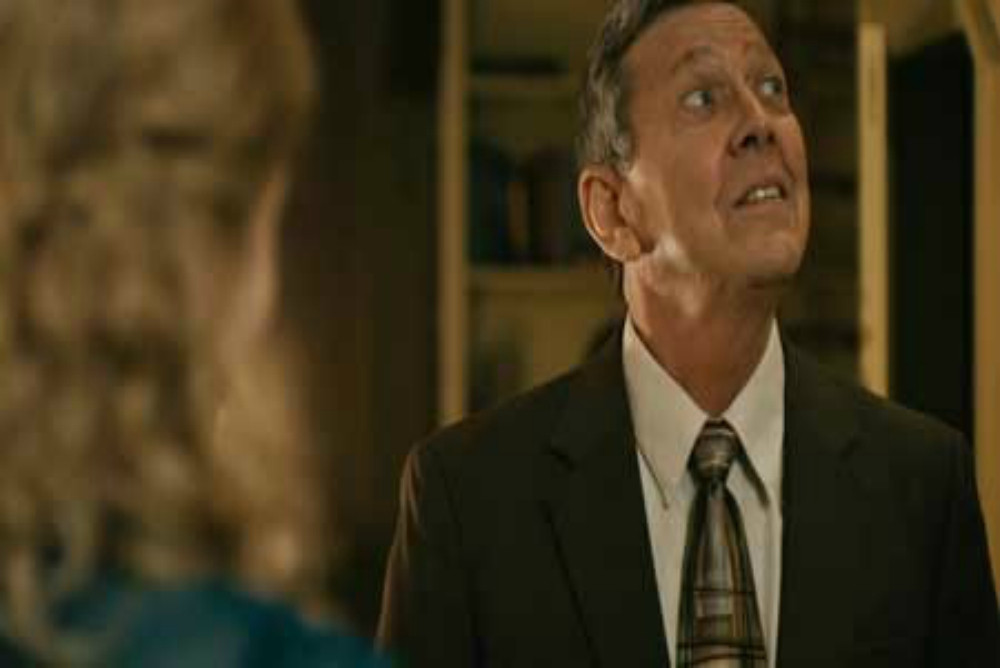The House on Pine Street firmly secures its place as a standout independent horror film of 2015, a year rich with genre gems. For discerning horror aficionados, it nestles comfortably in the ranks, just a hair’s breadth from the masterful tension of The Invitation and edging out the unsettling realism of They Look Like People. This film isn’t just another jump-scare fest; it’s a slow-burn descent into paranoia and the unknown, all set within the unsettling walls of The House On Pine Street.
Synopsis: A Return Home Turns Nightmarish
The film introduces us to Jenny (Emily Goss) and Luke (Taylor Bottles), a young couple seeking a fresh start by relocating from the bustling city of Chicago to Jenny’s quieter hometown in Kansas. Seven months pregnant and grappling with the aftermath of a mental breakdown linked to her pregnancy, Jenny finds herself back in familiar territory that offers little comfort. Her unease is palpable – dissatisfaction with Kansas, the looming presence of her overbearing mother, Meredith (Cathy Barnett), regret over leaving her Chicago life, and a complicated relationship with her impending motherhood all weigh heavily on her. As Jenny settles into the house on pine street, a sense of dread begins to permeate her reality, manifesting in increasingly strange and unsettling occurrences within the home.
Independent Spirit, Classic Horror Roots
The House on Pine Street is a testament to independent filmmaking, a passion project brought to life by the collaborative vision of Natalie Jones and directors Austin and Aaron Keeling. Forged by talents emerging from the University of Kansas and the University of Southern California, all under the age of twenty-four, the film carries an authentic and raw energy. Adding to its unique production story, the cast and crew immersed themselves in the very setting of their narrative, residing in the “haunted” house on Pine Street throughout the nineteen-day shoot – an experience echoing the gritty, immersive filmmaking of George Romero’s Night of the Living Dead.
What truly elevates The House on Pine Street is its skillful weaving of classic supernatural horror tropes with a distinctly modern psychological depth. The film subtly nods to literary giants without ever becoming derivative. For those familiar with the genre, echoes of Charlotte Perkins Gilman’s seminal short story, “The Yellow Wallpaper” (1892), and Shirley Jackson’s haunting novel, The Haunting of Hill House (1959), resonate throughout. These parallels are not merely cosmetic; they delve into shared thematic territory. A playful nod exists in character names and set design – Gilman’s narrator’s sister-in-law is named Jennie, and the nursery in the house on pine street is painted a disquieting yellow. Similarly, the film introduces a medium named Walter Vance, sharing a surname with Eleanor Vance, the protagonist of The Haunting of Hill House, and Jenny’s husband shares a first name with another central character from Jackson’s novel, Luke.
Alt text: Jenny, the pregnant protagonist in The House on Pine Street, looking distressed in her new home.
However, the film’s brilliance lies beyond these surface-level homages. Like Gilman and Jackson’s masterpieces, The House on Pine Street masterfully treads the ambiguous line between the supernatural and the psychological. Throughout the majority of the film, the audience is kept in suspense, questioning whether Jenny is genuinely experiencing paranormal events or if her profound unhappiness, intensified by her pregnancy, is manifesting as disturbing phenomena. Are the unsettling occurrences within the house on pine street external, spectral intrusions, or are they projections of Jenny’s own fractured mental state? In a moment of chilling self-awareness, Jenny voices a sentiment worthy of Shirley Jackson’s Eleanor Vance: “It’s the house. It’s in my head.” But the film compels us to question – is it truly all in her head? And what are the implications if it is? Does this suggest mere delusion, or something far more sinister – that the very house itself has invaded her psyche?
This central question forms the core of Gilman’s and Jackson’s works, and The House on Pine Street follows suit, centering on a deeply troubled female protagonist navigating societal and internal pressures. In all three narratives, the protagonists’ struggles are intricately linked to themes of femininity and motherhood – the anxieties of becoming a mother, the complexities of mother-daughter relationships, and the societal expectations placed upon women. Furthermore, The House on Pine Street subtly evokes Rosemary’s Baby (Roman Polanski, 1968), echoing Gilman’s exploration of female bodily autonomy during pregnancy. Jenny’s interactions with her mother, husband, and even her best friend are often framed in a way that suggests a subtle conspiracy, their focus seemingly more on the unborn child than on Jenny’s well-being. This perceived lack of control over her own life and body, this dismissal of her desires and needs, becomes Jenny’s central conflict, the true source of horror simmering beneath the surface of the house on pine street.
Alt text: A tense dinner scene in The House on Pine Street, highlighting the strained relationships between Jenny and her family.
Beyond its artful allusions and exploration of feminist subtext through the lens of motherhood, The House on Pine Street succeeds on a fundamental level: it’s genuinely frightening. It’s the kind of film that lingers, making everyday sounds amplify into potential threats and shadows dance with menace. The film’s scares are masterfully understated, hinting at unseen horrors rather than relying on gratuitous displays. Significantly, many of the most unsettling moments are rooted in Jenny’s interactions with the living – unsettling stares from strangers, an undercurrent of hostility that blurs the line between reality and paranoia, further fueling the central question of Jenny’s sanity and the reliability of her perception within the house on pine street.
Alt text: Close-up shot from The House on Pine Street showing Jenny’s hand reaching out towards an unseen presence, emphasizing the film’s suspense.
However, a minor misstep lies in the character of Walter Vance (Jim Korinke), the medium. His scenes, particularly his extended explanations, feel somewhat heavy-handed and disrupt the film’s otherwise subtle pacing. Walter’s role seems paradoxically aimed at explaining the inherent inexplicability of the paranormal. He delivers lines that, while thematically relevant, feel redundant: “the very definition of paranormal is that which cannot be explained,” emphasizing the “unknown” as the root of terror. While this initial exposition is arguably acceptable, Walter’s return later in the film with further explanations feels unnecessary, even detrimental. He attempts to elucidate an ambiguity that the narrative itself has already effectively established and explored through atmosphere and implication within the house on pine street.
Alt text: Walter Vance, the medium character in The House on Pine Street, in a scene that some critics found to be overly explanatory.
Walter’s late-film exposition also unfortunately delays the final scenes, which are arguably the most captivating and fitting conclusion. These scenes double down on the film’s central ambiguity, leaving the audience to ponder the true nature of the events. To what extent are the happenings in the house on pine street driven by external supernatural forces, and how much is a manifestation of Jenny’s own will, conscious or unconscious? The film deliberately withholds definitive answers, leaving a lingering sense of unease and prompting introspection long after the credits roll.
Final Verdict
111 minutes | Directed by Aaron and Austin Keeling | (USA) | 2015
Grade: A-
The House on Pine Street is a smart, chilling, and thought-provoking independent horror film that deserves a wider audience. It’s available on DVD and streaming platforms, ready to unsettle those brave enough to enter the house on pine street.
[


 2. hops dinner
2. hops dinner 3. HOPS3 Jennifer and hand
3. HOPS3 Jennifer and hand 4. HOPS Walter
4. HOPS Walter
